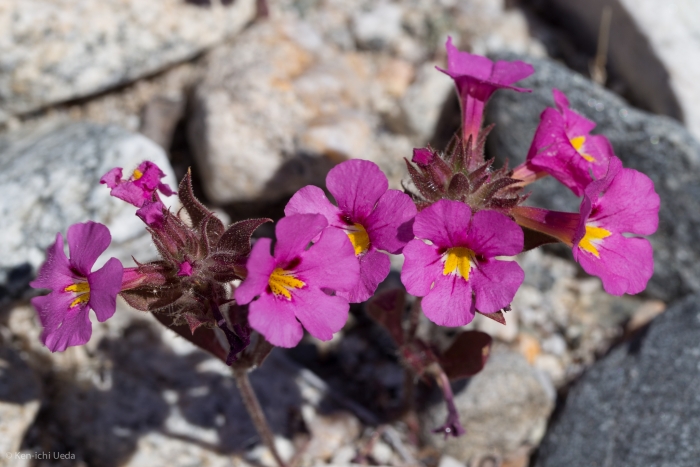Bigelow’s Monkeyflower
(Diplacus bigelovii)
Bigelow’s Monkeyflower (Diplacus bigelovii)
/
/

Ken-ichi Ueda
CC BY 4.0
Image By:
Ken-ichi Ueda
Recorded By:
Copyright:
CC BY 4.0
Copyright Notice:
Photo by: Ken-ichi Ueda | License Type: CC BY 4.0 | License URL: http://creativecommons.org/licenses/by/4.0/ | Rights Holder: Ken-ichi Ueda | Publisher: iNaturalist | Date Created: 2019-03-30T12:05:34-07:00 |



















































Estimated Native Range
Summary
Diplacus bigelovii, commonly known as Bigelow’s Monkeyflower, is an annual herb with a hairy texture, native to arid desert regions and chaparral scrublands in the Southwestern United States and Baja California. It typically grows to a height of 2 to 25 centimeters with an erect stem. The plant exhibits variability in size, shape, and color, with herbage ranging from green to nearly red. Its pointed oval or rounded leaves, up to 3.5 centimeters long, are arranged in opposite pairs along the stem. The flowers are notable for their tubular base encased by a reddish-green or purple ribbed calyx of hairy sepals with elongated lobe tips. The trumpet-shaped corolla, about one to two centimeters long, features a narrow tube that flares into a wide mouth, displaying two upper lobes and three lower. The corolla is typically magenta or deep pink with darker red, purple, and yellow spots in the throat, blooming in the spring and early summer.
Bigelow’s Monkeyflower is appreciated for its vibrant flowers and adaptability to dry conditions, making it suitable for xeriscaping and rock gardens. It is often used in wildflower mixes and as a border plant in areas with arid climates. This plant thrives in full sun to part shade and requires minimal water once established, preferring well-drained soils. While it is relatively low-maintenance, it can be susceptible to root rot if overwatered. Bigelow’s Monkeyflower is also valued for its ability to attract pollinators such as bees and hummingbirds.CC BY-SA 4.0
Bigelow’s Monkeyflower is appreciated for its vibrant flowers and adaptability to dry conditions, making it suitable for xeriscaping and rock gardens. It is often used in wildflower mixes and as a border plant in areas with arid climates. This plant thrives in full sun to part shade and requires minimal water once established, preferring well-drained soils. While it is relatively low-maintenance, it can be susceptible to root rot if overwatered. Bigelow’s Monkeyflower is also valued for its ability to attract pollinators such as bees and hummingbirds.CC BY-SA 4.0
Plant Description
- Plant Type: Herb
- Height: 0.5-0.7 feet
- Width: 0.714-1 feet
- Growth Rate: Moderate
- Flower Color: Pink, Purple
- Flowering Season: Spring, Summer
- Leaf Retention:
Growth Requirements
- Sun: Full Sun, Part Shade
- Water: Low
- Drainage: Fast
Common Uses
Bee Garden, Bird Garden, Butterfly Garden, Hummingbird Garden, Low Maintenance, Showy Flowers
Natural Habitat
native to arid desert regions and chaparral scrublands in the Southwestern United States and Baja California
Other Names
Common Names:
Scientific Names: , Mimulus bigelovii, Diplacus bigelovii, Mimulus bigelovii var. bigelovii, Eunanus bigelovii, Mimulus bigelovii var. panamintensis,
GBIF Accepted Name: Diplacus bigelovii (A.Gray) G.L.Nesom